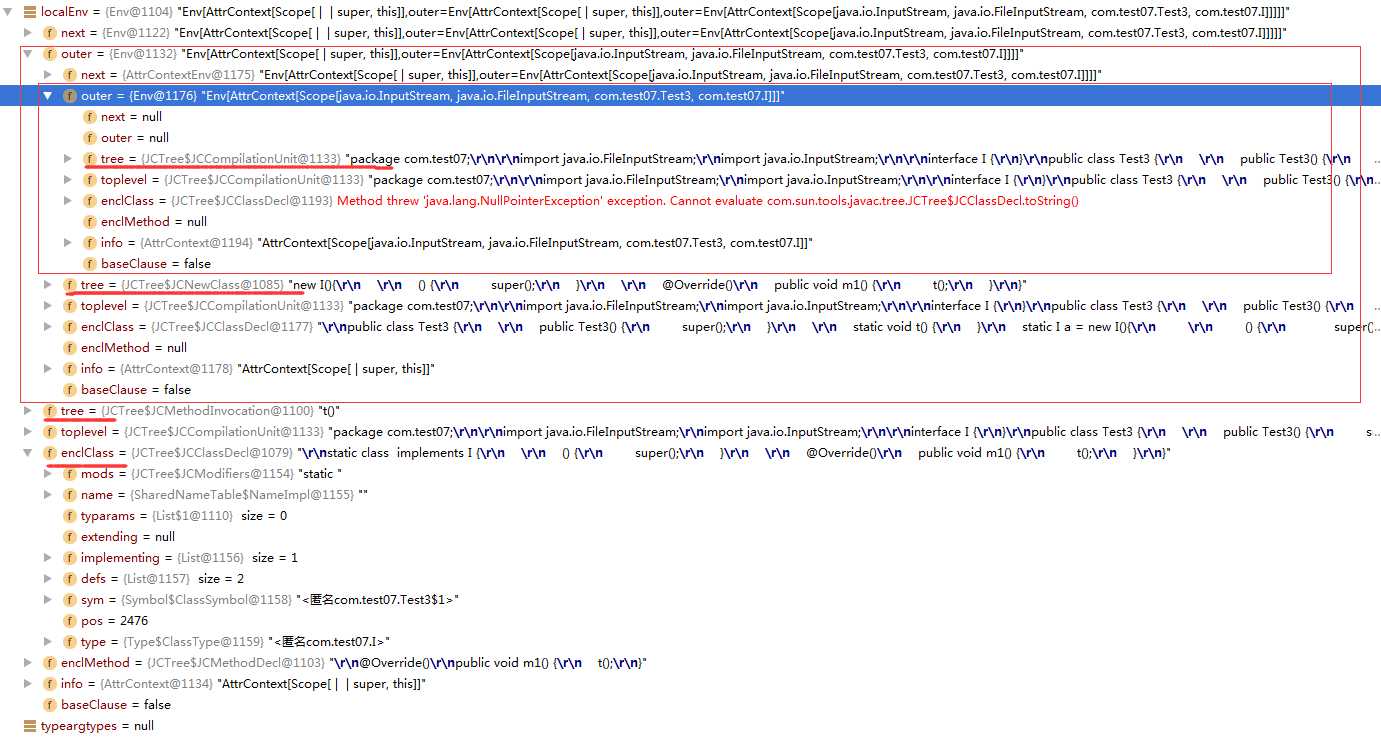标签:public his ble remove currently poi copy eve 组织
关于Env的源代码如下:
/** A class for environments, instances of which are passed as
* arguments to tree visitors. Environments refer to important ancestors
* of the subtree that‘s currently visited, such as the enclosing method,
* the enclosing class, or the enclosing toplevel node. They also contain
* a generic component, represented as a type parameter, to carry further
* information specific to individual passes.
*
* 一个类的环境,它的实例将被作为树访问者的参数进行传递。环境涉及到重要的子树的先祖,子树是目前被访问过的。例如封闭的方法、
* 封闭的类或者是封闭的顶层结点。它们也包含了一个一般性的组件,被描述为类型参数,针对个别的传递携带更多的信息
*
*/
public class Environment<A> implements Iterable<Environment<A>> {
/** The next enclosing env.
*
* 下一个封闭的环境,和作用域是不同的。这个与语法树的组织嵌套是一样的
*/
public Environment<A> next;
/** The env enclosing the current class.
*
* 封闭了当前类的环境,与语法树的组织嵌套一样的,只是只保存类的上一层嵌套结构,可能是Block,Class,JCCompilationUnit与JCNewClass
* 因为只有这几个结构中可以定义类
*/
public Environment<A> outer;
/** The tree with which this env is associated.
*
* 和当前环境相关联的语法树
*/
public JCTree tree; // 查看environment主要是看tree属性,看这个环境属于哪个语法节点即可
/** The enclosing toplevel tree.
*
* 封闭的顶层语法树,语法节点类型为JCCompilationUnit
*/
public JCCompilationUnit toplevel;
/** The next enclosing class definition.
*
* 封闭当前环境的类,也是最近的那个类。类的enclosingClass就是自己
*/
public JCClassDeclaration enclosingClass;
/** The next enclosing method definition.
* 下一个封闭的方法定义
*/
public JCMethodDeclaration enclosingMethod;
/** A generic field for further information.
*
* 一个能携带将来指定信息的通用属性。在这里一般是AttrContext
*/
public A info;
/** Is this an env for evaluating a base clause?
*
* 这是评估一个基础子句的环境,查看 MemberEnter类中的baseEnvironment()方法
*/
public boolean baseClause = false;
/** Create an outermost env for a given (toplevel)tree,with a given info field.
*
* 为一个给定的(顶层)节点树和一个给定的属性相关信息创建一个最外层的环境
*/
public Environment(JCTree jcTree, A info) {
this.next = null;
this.outer = null;
this.tree = jcTree;
this.toplevel = null;
this.enclosingClass = null;
this.enclosingMethod = null;
this.info = info;
}
/** Duplicate this env, updating with given tree and info,
* and copying all other fields.
*/
public Environment<A> duplicate(JCTree jcTree, A info) {
Environment<A> environment = new Environment<A>(jcTree, info);
Environment<A> copy = duplicateto(environment);
return copy;
// return duplicateto(new Environment<A>(tree, info));
}
/** Duplicate this env into a given Environment,using its tree and info, and copying all other fields.
*/
public Environment<A> duplicateto(Environment<A> that) {
that.next = this; // 将这个对象赋值给拷贝对象的next属性
that.outer = this.outer;
that.toplevel = this.toplevel;
that.enclosingClass = this.enclosingClass;
that.enclosingMethod = this.enclosingMethod;
// tree和info信息用that自己的
return that;
}
/** Duplicate this env, updating with given tree,and copying all other fields.
*/
public Environment<A> duplicate(JCTree jcTree) {
// 只更新了tree属性,其它的信息都使用这个环境的
return duplicate(jcTree, this.info);
}
/** Return closest enclosing environment which points to a tree with given typeTag.
*/
public Environment<A> enclosing(int tag) {
Environment<A> environment1 = this;
while (environment1 != null && environment1.tree.getTag() != tag){
environment1 = environment1.next;
}
return environment1;
}
public String toString() {
return "Environment[" + info + (outer == null ? "" : ",outer=" + outer) + "]";
}
public Iterator<Environment<A>> iterator() {
Iterator<Environment<A>> itr = new Iterator<Environment<A>>() {
Environment<A> next = Environment.this;
public boolean hasNext() {
return next.outer != null;
}
public Environment<A> next() {
if (hasNext()) {
Environment<A> current = next;
next = current.outer;
return current;
}
throw new NoSuchElementException();
}
public void remove() {
throw new UnsupportedOperationException();
}
};
return itr;
}
}
举个例子,如下:
interface I{
void m1();
}
public class Test3{
static void t(){}
static I a = new I(){
@Override
public void m1() {
t();
}
};
}
那么t()的环境Env的结构如下截图。

这是outer属性,而next属性和语法树的组织结构是严格一致的,如下截图。

而其中的info属性一般为AttrContext,源代码如下:
/** Contains information specific to the attribute and enter
* passes, to be used in place of the generic field in environments.
*
*/
public class AttrContext {
/** The scope of local symbols.
*/
Scope scope = null;
/** The number of enclosing `static‘ modifiers.
*/
int staticLevel = 0;
/** Is this an environment for a this(...) or super(...) call?
*/
boolean isSelfCall = false;
/** Are we evaluating the selector of a `super‘ or type name?
*/
boolean selectSuper = false;
/** Are arguments to current function applications boxed into an array for varargs?
*/
boolean varArgs = false;
/** A list of type variables that are all-quantifed in current context.
*/
List<Type> tvars = List.nil();
/** A record of the lint/SuppressWarnings currently in effect
*/
Lint lint;
/** The variable whose initializer is being attributed
* useful for detecting self-references in variable initializers
*/
Symbol enclVar = null;
/** Duplicate this context, replacing scope field and copying all others.
*/
AttrContext dup(Scope scope) {
AttrContext info = new AttrContext();
info.scope = scope;
info.staticLevel = staticLevel;
info.isSelfCall = isSelfCall;
info.selectSuper = selectSuper;
info.varArgs = varArgs;
info.tvars = tvars;
info.lint = lint;
info.enclVar = enclVar;
return info;
}
/** Duplicate this context, copying all fields.
*/
AttrContext dup() {
return dup(scope);
}
public Iterable<Symbol> getLocalElements() {
if (scope == null)
return List.nil();
return scope.getElements();
}
public String toString() {
return "AttrContext[" + scope.toString() + "]";
}
}
在如上的例子中,JCVariableDecl节点及子结点的staticLevel都为1,而其父结节点及以上为0。再举个例子,如下:
public class Test3{
static{ // staticLevel = 1
// 在static块中不允许再有static出现,如
// static int a = 1;
// static class A{}
// class A{
// public static void m1(){}
// }
int a = 1; // staticLevel = 1
}
// 这个类的staticLevel为0,与一般类没有任何区别
static class Inner{ // staticLevel = 0
public static void m1(){ // staticLevel = 1
int b = 1; // staticLevel = 1
}
}
}
标签:public his ble remove currently poi copy eve 组织
原文地址:http://www.cnblogs.com/extjs4/p/7628811.html